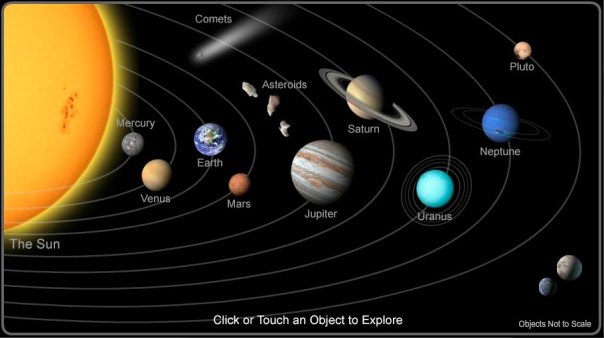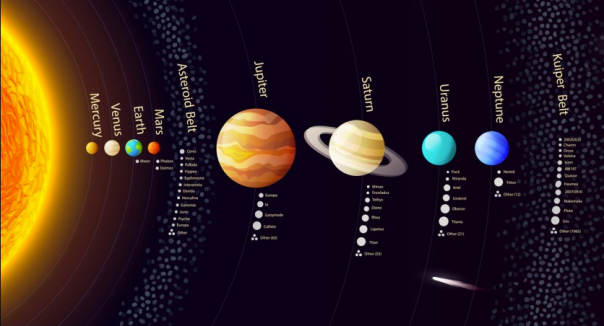Our Solar System
Earth and Space is a very unique chapter as it normally instills a massive sense of existentialism (questioning our role in the universe) and rightfully so as when we can wrap our heads around the mystery of the space, we realize how small we truly are.
Let’s get some vocabulary out of the way first so we can get to the interesting stuff.
You and I and everyone we know live on a Planet. Our planet is called Earth and we named it that way. There are planets in our solar system and what we have in common with the other planets is that we all orbit around a star. In the English language, we refer to our star as the sun.

What qualifies an astral body (fancy word for space objects) to be a planet is that it must orbit around the sun. The moon, is not a planet because it orbits around Earth, and not the sun. This is why there is a debate about whether or not Pluto is a planet, because it orbits the sun, but its orbital path is affected by other nearby planets. For the sake of this course, let’s say that it does count as a planet.
Please learn the names of the planets, their order from closest to furthest from the sun and their size from smallest to biggest.
Some of you might notice that there are some asteroids between Mars and Jupiter, there is actually millions of smaller space rocks there as well in what is known as the Asteroid Belt. This belt separates what is known as the inner planets from the outer planets. Mercury, Venus, Earth and Mars would be called inner planets, while Jupiter, Saturn, Uranus, Neptune and Pluto would be called the outer planets. Beyond Pluto, there is another series of asteroids called the Kuiper Belt. You can refer to this as the outer limits of solar system and separates our solar system with interstellar space (space between stars).

Astronomical Unit (AU)
For distances in our solar system, we have defined the measurement value of the Astronomical Unit (AU) equivalent to the distance between the sun and Earth.
- Distance between sun and Earth:
- 149,597,870,700 metres = 1.0 AU
- Distance between sun and Jupiter:
- 778,547,200,000 metres = 5.2 AU
- (I found this number using simple proportions)
- Example question: there is a new planet found at 3.2AU. How far is it from the sun?
Earth – The only planet with confirmed life
As you might have guessed, Earth is a planet with life on it. Earth has millions of different species of bacteria, yeast, plants, animals and others living on it, all of which are capable of some time of cellular respiration, or ATP synthesis.
However, what is so special about Earth that allows life to exist on it?
- The presence of water: this is the most common molecule found in the cells of living systems.
- Temperature: Earth is located at what is called the temperate zone, which is to say that it is neither too close or too far from the sun, allowing it to be in just the right temperature range. This temperature is required for water to exist as a liquid on Earth, and not ice or vapor.
- Atmosphere: Our atmosphere is composed of O2, which is essential for most life forms, and CO2 which is essential for photosynthesis. The atmosphere also protects life from harmful radiation waves from the sun. The atmosphere is also responsible for warming the planet, trapping some of the solar energy given to us by the sun.
- Solid core: It is very important that our planets core is ferrous (made of iron) and has molten tectonic plates floating on top. Have a solid crust over the planet also means that life can exist on it, whereas it would not be possible if Earth was a gas planet. It also helps that Earth has a magnetic field.
- Earth has an axial tilt of 23.4°: This allows for the planet to be heated more evenly by the sun and create a more comfortable range in temperature, also giving rise to seasons.
- Presence of a moon: Because the moon is a relatively massive object that is located relatively close to the planet, it plays a role on our gravitational orbit, causing Earth to “wobble”. Along with other factors, the moon allows for the presence of tides, a very important factor to how life came from being aquatic to being terrestrial.
- Earth’s size: the size of the planet plays an important role to maintaining the perfect gravitational pull. If the planet were any less dense, then gravity would be too little and life could be affected. If the planet was too dense, then there would be too much gravity, and again life would not be able to exist.